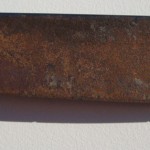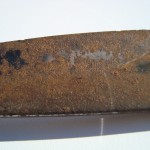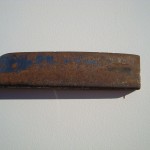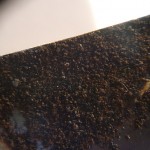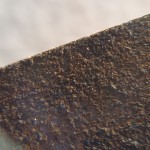In this series we will explore fatal razor problems. We either cannot hone or restore the razor, the odds of success are too low, or the cost of restoration far exceeds the benefit/value of the razor. We will post pictures and provide you, the reader, with detailed explanations of what is wrong with the razor and what to look out for when purchasing old/vintage straight razors.
In this article, we look at the problem of rust. Rust is the killer of all things steel. As I pointed out in this article, carbon steel is made up of iron and carbon. Unfortunately, iron’s natural form is iron oxide. Thus, steel continually wants to revert to this form; we call it rusting. As you well know rust eats away at the structure of steel, both weakening the surrounding metal and causing catastrophic holes in the steel. Rust is just as bad for straight razors.
How to Prevent this from Happening
There is hope though. If the rust is only on the surface and hasn’t eaten too deep, the result may be only cosmetic in nature. If the rust has developed over a long time, pits have developed. When the rust is removed, these pits will look like craters in the steel. Again, this is a cosmetic issue as long as the pits are not near or on the edge. If there is any pitting or rust on the edge, the razor is in trouble.
We can remove the rust in the edge, but if there is no good steel above the rusted edge, then there is no hope. A close visual inspection can ascertain the odds of success, but only after removing the rust can we be certain whether the steel structure is sound. Conversely, if the rust is on the spine or nowhere near the edge of the razor, the razor is fine. The rust is cosmetic in nature only.
The pictures at the beginning of this post show a razor that is beyond saving. The edge is covered with rust. Below are closeups of the edge. The razor is a wedge, so there is a remote possibility of it being saved. The process involves regrinding the razor and removing the entire affected edge until good steel is revealed. The cost of such an operation is extensive. As you can see in the photos below, the rust was thorough and pervasive. This razor has seen the end of its useful life. Sadly, with just a little more care, the razor could have been easily saved.
Why these razors cannot be saved
In this section I will go over why these problem razors either cannot or are not worth saving. Although if the razor is priceless, it might be worth trying to save it. In this particular case, the rust is extensive. As you can see in the above photos, the rust not only goes up to the edge, but it covers the entire cutting surface. A 20x closeup shows just how bad the rust has eaten away at the steel.
This razor can be made shiny again. Do not doubt that. However, the areas of steel that the rust has eaten away will remain. They will remain as craters in the surface of the steel. Now, as I’ve said before, if these craters were only on the face of the razor, not the edge, they would only be aesthetic. However, when these craters appear on the edge of the razor, it presents a problem. The straight razor restoration community calls the problem “the Swiss cheese effect.” We call it that because the edge looks like Swiss cheese when viewed under magnification. This is a fatal flaw because a razor’s edge needs to be perfectly smooth in order to shave well. Now, just looking at the photos you wouldn’t want to shave with the razor in its current condition. But what if I told you, I could grind away all that rust and expose shiny, new metal underneath? Sounds promising right? Okay, but now what if I told you that even though I could make it shiny again, the razor’s edge would be riddled with pock marks and craters? See the below photo and extrapolate what the edge will look like with all those pits in it. Again, click for higher resolution.
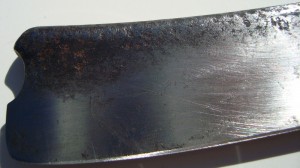 Okay, your focusing on the top of the razor. See those craters? Those craters are the pits. Now, as you can see, those pits run deep into the metal. Take note: this razor is in excellent shape; the rust is nowhere near the edge, any rust that was I was able to grind away and expose fresh, clean metal underneath. Okay. Now, imagine those pits in the edge of the above razor. That’s pretty much exactly what the edge is going to look like. The edge is going to have holes everywhere. Yet, that is not all that rust does. Read on for more info on crumbling.
Okay, your focusing on the top of the razor. See those craters? Those craters are the pits. Now, as you can see, those pits run deep into the metal. Take note: this razor is in excellent shape; the rust is nowhere near the edge, any rust that was I was able to grind away and expose fresh, clean metal underneath. Okay. Now, imagine those pits in the edge of the above razor. That’s pretty much exactly what the edge is going to look like. The edge is going to have holes everywhere. Yet, that is not all that rust does. Read on for more info on crumbling.
Now that I’ve shown you the obvious visual signs of why you wouldn’t want to shave with such a jagged edge, I’m going to explain another phenomenon that rust does. We call it crumbling. Rust not only infects the surface of the razor, but as you can see, it digs in deep and forms large craters if left unchecked. Yet, rust doesn’t form perfect little craters, rust acts like a plant’s roots, expanding into the metal and digging in eroding the good steel and turning it into iron oxide. Just like a tree’s roots dig deep and expand in all directions, so too does rust.
This expansion into the heart of the steel is invisible. It is the silent killer of straight razors. These rust tendrils cause catastrophic collapse of the steel structure. They undermine the crystalline structure of the steel and erodes the supporting molecules. In other words, the rust weakens the steel causing it to crumble under pressure. What this means is that when the razor is being sharpened, the rust will crumble away due to no structural strength. In other words, the razor cannot get sharp. It won’t hold an edge. Well, it will still cut, but you wouldn’t want to shave with it. Unfortunately, the only way we can tell whether this crumbling effect is going to happen is when we hone the razor.
The good news is that its not all doom and gloom. Even if the edge crumbles, wedge razors can still be saved. This is because of the large amount of steel left on the razor. We can grind away the bad edge until good steel is found. Not so much with hollow razors. Yet, like all things, it depends. Send us pictures for an assessment. Okay, now the bad news. The bad news is that this process takes hours. Consequently, it is extremely expensive. All hope is not lost, but all hope of a restoration costing under $200 is.

